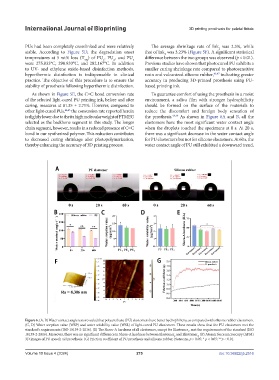Page 283 - IJB-10-4
P. 283
International Journal of Bioprinting 3D printing prosthesis for palatal fistula
PUs had been completely crosslinked and were relatively The average shrinkage rate of Ink was 2.3%, while
2
stable. According to Figure 5D, the degradation onset that of Ink was 3.23% (Figure 5F). A significant statistical
4
temperatures at 5 wt% loss (T ) of PU , PU , and PU difference between the two groups was observed (p < 0.01).
3
5%
2
1
were 275.833°C, 290.833°C, and 282.167°C. In addition Previous studies have shown that photocured PU exhibits a
to UV- and ethylene oxide-based disinfection methods, smaller curing shrinkage rate compared to photosensitive
hyperthermic disinfection is indispensable in clinical resin and vulcanized silicone rubber, 46,47 indicating greater
practice. The objective of this procedure is to ensure the accuracy in producing 3D-printed prosthesis using PU-
stability of prosthesis following hyperthermic disinfection. based printing ink.
As shown in Figure 5E, the C=C bond conversion rate To guarantee comfort of using the prosthesis in a moist
of the selected light-cured PU printing ink, before and after environment, a saliva film with stronger hydrophilicity
curing, measures at 81.35 ± 2.71%. However, compared to should be formed on the surface of the materials to
other light-cured PUs, 44,45 the conversion rate reported herein reduce the discomfort and foreign body sensation of
is slightly lower due to the its high molecular weight of PTMEG the prosthesis. 48,49 As shown in Figure 6A and B, all the
selected as the backbone segment in this study. The longer elastomers have the most significant water contact angle
chain segment, however, results in a reduced presence of C=C when the droplets touched the specimens at 0 s. At 20 s,
bond in our synthesized polymer. This reduction contributes there was a significant decrease in the water contact angle
to decreased curing shrinkage after photopolymerization, for PU elastomers but not for silicone elastomers. At 60 s, the
thereby enhancing the accuracy of 3D printing process. water contact angle of PU still exhibited a downward trend,
Figure 6. (A, B) Water contact angle tests revealed that polyurethane (PU) elastomers have better hydrophilicity, as compared with silicone rubber elastomers.
(C, D) Water sorption value (WSP) and water solubility value (WSL) of light-cured PU elastomers. These results show that the PU elastomers met the
standard’s requirements (ISO 10139-2-2016). (E) The Shore-A hardness of all elastomers, except for Elastomer , met the requirements of the standard (ISO
1
10139-2-2016). Moreover, there was no significant difference in Shore-A hardness between Elastomer and Elastomer . (F) Atomic force microscopy (AFM)
2
4
3D images of PU speech aid prosthesis. (G) Friction coefficient of PU prosthesis and silicone rubber. Notes: ns, p > 0.05; * p < 0.05; **p < 0.01.
Volume 10 Issue 4 (2024) 275 doi: 10.36922/ijb.2516

